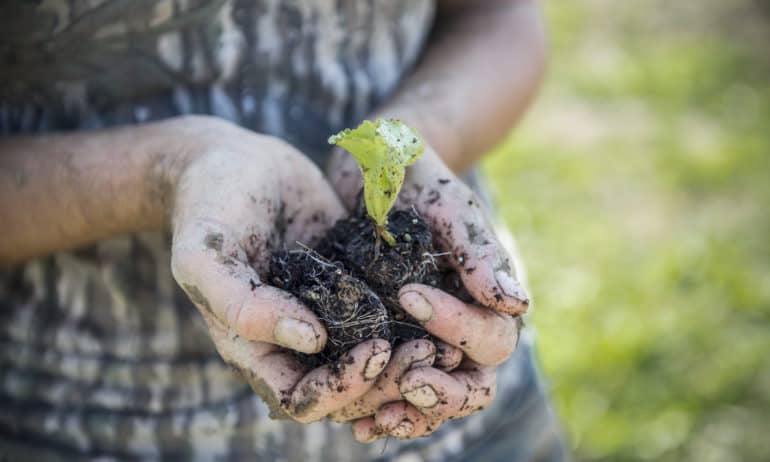



Dr. Kristine Nichols was the Chief Scientist at the Rodale Institute, an independent research institute for organic farming, from 2014 to 2017. Her training and research focus on the microbes living in soil and how to make soil more productive.
The Rodale Institute was founded in 1947 in Kutztown, PA by J.I. Rodale. Inspired by the nitrogen fertilizer shortages during World War II, Rodale wanted to develop practical methods of rebuilding soil fertility. Today, the institute focuses particularly on compost, soil health, weed and pest management, livestock operations, organic certification, wastewater treatment, and climate change. It is home to the longest running comparative study of organic and chemical agriculture, started in 1981.


Food Tank had the opportunity to talk to Dr. Kristine Nichols about how soil microbes affect agriculture and about some of the trials the Rodale Institute are conducting.
Food Tank (FT): What is the importance of soil microbes to agriculture and how are they affected by different agricultural systems and changing climates?
Kristine Nichols (KN): Soil microbes are key to the function of agricultural systems. Microbial populations play roles in nutrient cycling, from fixing nitrogen to solubilizing phosphorus. Some microbes assist in the formation of soil aggregates that improve pore space in the soil, which allows for higher infiltration rates, better water-holding capacity, and lowers the compaction that often impedes root growth. Other microbes are involved in extensive predator and prey relationships that can reduce the prevalence of disease. Many microorganisms are involved in organic matter decomposition, which releases nutrients needed by other microbes and plants, while others break down soil minerals for nutrient cycling. Several organisms play multiple roles in the soil or have roles that may change based on the microenvironment. Others work in complex consortia to satisfy functional needs.
Different agricultural systems and changing climates impact microbial communities. Although the impacts of changing climate are felt less directly be microbial communities, changing precipitation patterns can affect them by creating prolonged aerobic or anaerobic conditions. Typically, agricultural management practices have more of an impact on microbial communities.
Insecticides not only kill macroscopic insects, they also kill microscopic insects, or microarthropods. The normal cycle is for microarthropods to shred organic matter for bacteria and fungi. The bacteria and fungi are then eaten by protozoa and nematodes, which ‘poop’ out nitrogen and other elements as nutrients for plants. Without microarthropods, many bacterial and fungal populations within the soil foodweb begin to decline. This then impacts concentrations of protozoa and nematodes and reduces the amount of nitrogen available for plants. Fungicides directly kill some populations of fungi and nematicides kill all nematodes, most of which aren’t plant pathogens. All of this killing negatively impacts diversity, nutrient cycling, and other functions in ways we do not currently understand. We are still learning about the impacts of herbicides. One thing that we do know is that one of the most widely used herbicides, glyphosate, is a strong metal chelator and metals are important components of enzymes that impact biochemical functions in micro- and macro-organisms. Therefore, they are impacting microbial populations but we don’t fully understand all of these processes yet.
When it comes to synthetic fertilizer use, there are direct and indirect impacts on microbes. The direct impacts stem from the fact that most fertilizers are salt-based, which disrupts hydrologic activities, essentially ‘stealing’ water away from microbes. Ammonia-based fertilizers increase the acidity of our soils and are initially toxic to living organisms that come in contact with them. Several people argue that these impacts are small and microbial populations recover and recolonize an area where other microbes have been killed because they feed on the dead bodies of those microbes. But the long-term impacts of repeated usage may be very large and we don’t know for sure what microbial populations we lost or which ones are increasing by these processes and the impact on overall soil function. The indirect impacts of fertilizers are that we are basically ‘outsourcing the jobs’ of the microbes that are normally involved in cycling and delivering nutrients to the plants. These microbes often receive a carbon ‘payment’ for this service that they can then use to grow and reproduce, but if the fertilizers are satisfying the nutrient demands from the plant without the plant having to ‘pay’ for them, then the microbes do not receive enough carbon to grow and reproduce.
Tillage is another disruptive practice because it physically tears apart the bodies of fungi. It also breaks apart soil aggregates that fungi and bacteria put energy and resources into creating and serve as a habitat for these bacteria and fungi. We recommend reducing the frequency and depth of tillage as well as the overall amount of soil that is disrupted by a particular tillage tool.
A diverse crop rotation that has at least three, but ideally more like five to ten different crops in the rotation sequence, provides a diverse ‘diet’ to the microbial community and stimulates diversity that builds resilience. The most important thing that a farmer is harvesting is sunlight and using cover crops, companion crops, double cropping, and/or perennial phases are a way for this to happen. We need to ‘keep something green and growing’. Managing livestock, pollinators, and predators, especially predatory insects, are other ways in which soil microbes receive benefits both directly and indirectly. Indirect impacts are often on the plants which provide most of the food sources for soil microbes either as root exudates or plant tissue/residue. Directly there are impacts on the diversity of microbes because these are mechanisms for new microbes to be transported into a new environment and impacts on the physical environments for microbes.
FT: How can soil improve food security and combat climate change?
KN: Soil health is critical to both food security and combating climate change because soil is the foundational resource for our food production—basically, without soil, we cannot grow food. Although an argument can be made that we can grow food hydroponically without soil, the resources needed to produce nutrient dense food would be very costly—fiscally and environmentally. Also, research indicates that there are some amino acids and antioxidants important for human health that can only be produced by fungi and some bacteria, meaning that they only get into the human food chain through a connection to the soil. Food security is no longer just about having enough food, it is also about having nutrient dense food so we can solve the twin crises of malnutrition and obesity that we are finding within the same families and sometimes within the same people.
When it comes to combating climate change, we are also confronting a dual threat that a focus on soil health will solve for us. If we can design agricultural production systems that are using biologically-based practices to regenerate soil, we will sequester more carbon (i.e. build soil organic matter). This will also reduce nitrous oxide emissions by reducing nitrogen fertilizer use, particularly if leguminous cover crops are managed appropriately. These systems seem to be more resilient against climatic uncertainty because they have more water-stable soil aggregates, allowing water to get into the soil faster (i.e. reducing runoff) and be held in the soil between rainfall events (i.e. increase drought tolerance).
FT: The Farming Systems Trial (FST) at RI is the longest-running comparison of organic and chemical agriculture in the United States. What has been learned since it started in 1981 and what objectives for the trial still remain?
KN: Initially this study was designed to determine how to grow organic grain crops in large-scale fields and how production compared to conventional grain crop yields. Over the years, the goals of this study have evolved to include reducing environmental and health risks in agriculture, improving crop productivity (i.e. yield), water quality, protection of natural resources, and the quality of life for farmers, their employees, and the farm community, reducing costs, increasing net farm income, conserving soil, and mitigating climate change. In 2016, an additional goal was added to evaluate the impacts of management practices on the nutritive quality of food, particularly how soil health is linked to human health.
FT: An offshoot of the FST is the Vegetable System Trial, in which you are examining the soil health and crop nutrition under the two agricultural systems. As you wrap up your first season, what have you found and what are the future goals of the program?
KN: The main goal to link soil health and human health remains the same and will probably continue for several years. Along the way, Dr. Smith, who is the Director of the project, is examining innovative ways to manage pests and diseases and the impacts of drought-stress or no irrigation on production and quality.
FT: What big questions in agriculture do you think still need to be answered?
KN: Agriculture is imperative to human survival—providing nutritious food, clean air and water, and maintaining the soil resource. The challenges that agriculture faces are not new, but we need to take a new (really an old) approach to solving them. Agriculture has always been a risky business, subject to whims of weather, pest, and disease. Modern agriculture is also plagued by economic volatility and outside pressures, which is strange given how vital it is to our survival as a species.
The approach that we need to take rests in using a systems approach with the soil as the foundation even though soil is something that we don’t fully understand and quite possibly never will. We need to identify the agricultural practices that will maximize the use of this soil resource and allow us to eliminate the use of offsite inputs, particularly synthetic fertilizers and pesticides. We also need to understand the best ways to integrate livestock into the system. As we start to put biologically-based, soil enhancing tools into place, we will increase soil organic matter and biological activity. This will automatically improve water and nutrient use efficiency and reduce soil loss and greenhouse gas emissions—particularly nitrous oxide, methane, and carbon dioxide. This will allow farmers to produce abundant and nutritious food under climatic uncertainty.
The good news is that we now have a better understanding of the platform (i.e. systems approach with a soil foundation) that we need to use. It will solve the economic and environmental problems of agriculture as well as the needs for nutrient dense food by our growing population. It will also help us to adapt to and mitigate climate change. The bad news is that we have a lot that we need to learn about the management practices we need to implement (i.e. crop rotation, cover crops, equipment, use of insectary strips or trap crops, pollinators, predators, etc.).
Nggak Nyangka! Hidup Gue Berubah Total! Gue bukan siapa-siapa. Cuma anak kos biasa yang kerja serabutan buat nutup biaya hidup… Read More
What is the Main Cause of a Heart Attack? What is its Solution? A heart attack is the blockage of… Read More
In the vast economic arena, one term that often takes center stage, inciting extensive debates and discussions, is the "debt… Read More
De-Dollarization: The Changing Face of Global Finance The financial landscape is in a state of flux, with an intriguing economic… Read More
The curtains closed on a dramatic Bundesliga season with Bayern Munich standing tall once again, clinching their 11th straight title.… Read More
The Unfolding Story of Celine Dion's Health In recent news that has left fans across the globe stunned, iconic singer… Read More